
French fries, chips, finger chips, French-fried potatoes, or simply fries are batonnet or allumette-cut deep-fried potatoes, originating from either Belgium or France. They are prepared by cutting the potato into even strips, then drying and frying it, usually in a deep fryer. Most french fries are produced from frozen Russet potatoes.
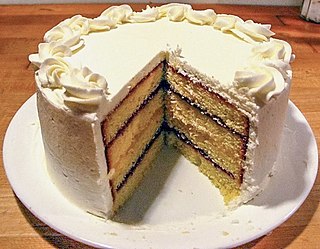
Cake is a form of sweet food made from flour, sugar, and other ingredients, that is usually baked. In their oldest forms, cakes were modifications of bread, but cakes now cover a wide range of preparations that can be simple or elaborate, and that share features with other desserts such as pastries, meringues, custards, and pies.

Pastry is a dough of flour, water and shortening that may be savoury or sweetened. Sweetened pastries are often described as bakers' confectionery. The word "pastries" suggests many kinds of baked products made from ingredients such as flour, sugar, milk, butter, shortening, baking powder, and eggs. Small tarts and other sweet baked products are called pastries. Common pastry dishes include pies, tarts, quiches, croissants, and pasties.

A crêpe or crepe is a type of very thin pancake. Crêpes originated in Brittany during the 13th century, but are now consumed around the world. Crêpes are usually one of two varieties: sweet crêpes or savoury galettes. They are often served with a wide variety of fillings such as jam, Nutella, berries, spinach, and chicken. Crêpes can also be flambéed, such as in crêpes Suzette.
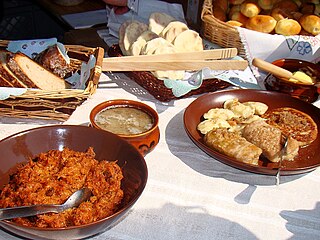
Polish cuisine is a style of cooking and food preparation originating in or widely popular in Poland. Polish cuisine has evolved over the centuries to become very eclectic due to Poland's history and it shares many similarities with neighbouring German as well as Ashkenazi Jewish culinary traditions and vice-versa. Polish-styled cooking in other cultures is often referred to as à la polonaise.

Danish cuisine originated from the peasant population's own local produce and was enhanced by cooking techniques developed in the late 19th century and the wider availability of goods during and after the Industrial Revolution. Open sandwiches, known as smørrebrød, which in their basic form are the usual fare for lunch, can be considered a national speciality when prepared and decorated with a variety of fine ingredients. Hot meals are typically prepared with meat or fish. Substantial meat and fish dishes includes flæskesteg and kogt torsk with mustard sauce and trimmings. Ground meats became widespread during the industrial revolution and traditional dishes that are still popular includes frikadeller, karbonader and medisterpølse. Denmark is known for its Carlsberg and Tuborg beers and for its akvavit and bitters, but amongst the Danes themselves imported wine has gained steadily in popularity since the 1960s.
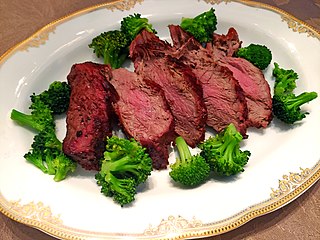
Chateaubriand is a dish that traditionally consists of a large center cut fillet of tenderloin grilled between two lesser pieces of meat that are discarded after cooking. While the term originally referred to the preparation of the dish, Auguste Escoffier named the specific center cut of the tenderloin the Chateaubriand.

A baked potato, known in some parts of the United Kingdom as a jacket potato, is a preparation of potato. The ideal baked potato has a fluffy interior and a crispy skin. It may be served with fillings, toppings or condiments such as butter, cheese, sour cream, gravy, baked beans, and even ground meat or corned beef.

Baumkuchen is a kind of spit cake from German cuisine. It is also a popular dessert in Japan. The characteristic rings that appear when sliced resemble tree rings, and give the cake its German name, Baumkuchen, which literally translates to "tree cake" or "log cake".

Czech cuisine has both influenced and been influenced by the cuisines of surrounding countries and nations. Many of the cakes and pastries that are popular in Central Europe originated within the Czech lands. Contemporary Czech cuisine is more meat-based than in previous periods; the current abundance of farmable meat has enriched its presence in regional cuisine. Traditionally, meat has been reserved for once-weekly consumption, typically on weekends. The body of Czech meals typically consists of two or more courses; the first course is traditionally soup, the second course is the main dish, and the third course can include supplementary courses, such as dessert or compote. In the Czech cuisine, thick soups and many kinds of sauces, both based on stewed or cooked vegetables and meats, often with cream, as well as baked meats with natural sauces (gravies), are popular dishes usually accompanied with beer, especially Pilsner, that Czechs consume the most in the world. Czech cuisine is also very strong in sweet main courses and desserts, a unique feature in European cuisines.

A charlotte is a type of dessert or trifle that can be served hot or cold. It is also referred to as an "icebox cake". Bread, sponge cake or biscuits/cookies are used to line a mold, which is then filled with a fruit puree or custard. It can also be made using layers of breadcrumbs.

Gratin is a culinary technique in which an ingredient is topped with a browned crust, often using breadcrumbs, grated cheese, egg or butter. Gratin is usually prepared in a shallow dish of some kind. A gratin is baked or cooked under an overhead grill or broiler to form a golden crust on top and is often served in its baking dish.
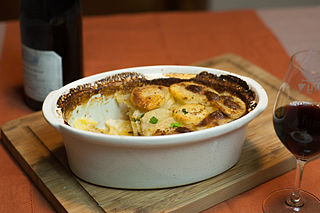
Gratin dauphinois is a French dish of sliced potatoes baked in milk or cream, using the gratin technique, from the Dauphiné region in south-eastern France. There are many variants of the name of the dish, including pommes de terre dauphinoise, potatoes à la dauphinoise and gratin de pommes à la dauphinoise. It is called potatoes au gratin in American English.

Spekkoek is a type of Indonesian layer cake. It was developed during colonial times in the Dutch East Indies. The firm-textured cake is an Indo (Dutch-Indonesian) version of the European multi-layered spit cake. However it is not baked on a rotating spit, and contains a mix of Indonesian spices, such as cardamom, cinnamon, clove, mace and anise. The cake is made of flour and yolk and is rich in butter or margarine.

Shirred eggs, also known as baked eggs, are eggs that have been baked in a flat-bottomed dish; the name originates from the type of dish in which it was traditionally baked. Shirred eggs are considered a simple and reliable dish that can be easily varied and expanded upon. An alternative way of cooking is to crack the eggs into individual ramekins, and cook them in a water bath, creating the French dish œufs en cocotte.
Adolphe Dugléré[adɔlf dyɡleʁe] was a French chef and a pupil of Marie-Antoine Carême.

The pâté aux pommes de terre, pronounced [pɑte o pɔm də tɛʁ], or pâté de pommes de terre is a speciality of the Limousin and the Allier (Bourbonnais) regions in Central France. It can be served either as a side dish or as the main course. Today it is often eaten with a green salad. Its main ingredients are potato slices and crème fraîche, which are used to fill a puff pastry crust. The pie is then baked in the oven until the dish is covered with a golden-brown crust.
A great variety of cassava-based dishes are consumed in the regions where cassava is cultivated, and they include many national or ethnic specialities.
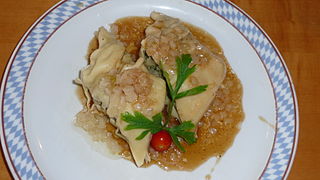
In comparison with the more French-influenced Baden cuisine, Swabian cuisine is rather simple and rustic. It is native to Swabia, which comprises great parts of Württemberg and the Bavarian part of Swabia, as well as the Allgäu which has parts lying in Austria.

















